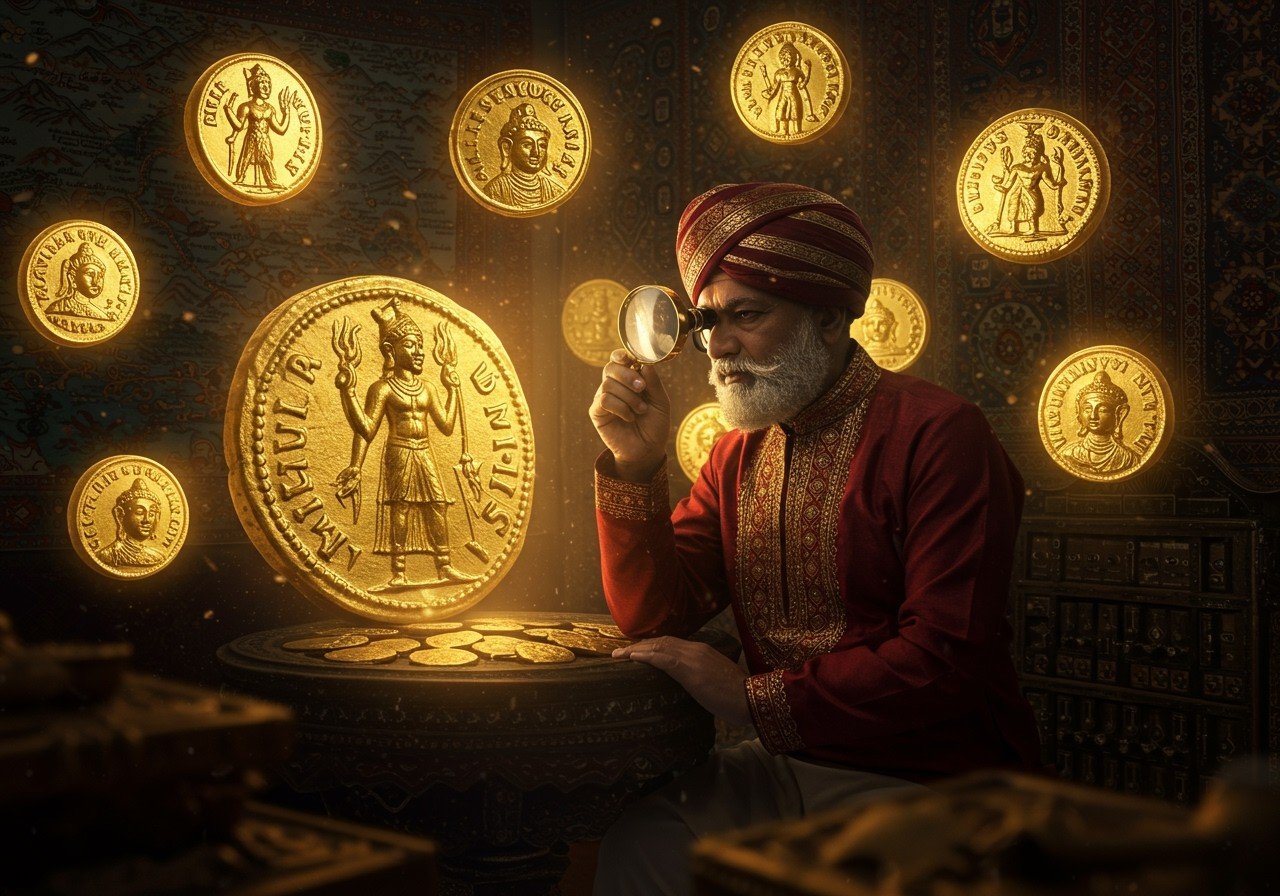
Kushan coinage stands as a cornerstone of ancient Indian numismatics, offering a glimpse into the socio-economic and cultural landscape of the Kushan Empire. Understanding the significance of these coins, the materials used in their creation, and their impact on trade and economy during the Kushan period (circa 1st to 3rd century CE) is crucial for appreciating this era. This guide provides a detailed overview for culturally aware individuals, particularly middle to upper-middle-class Indians who appreciate tradition and historical artifacts.
The Kushan Empire: A Historical Overview
The Kushan Empire, a powerful force in Central Asia and Northern India, left an indelible mark on history. Originating from the Yuezhi people who migrated from China to Bactria, the empire flourished under prominent rulers such as Kujula Kadphises (circa AD 50), Vima Kadphises, and the illustrious Kanishka the Great. These leaders spearheaded territorial expansion and established the empire’s influence. The Kushan Empire played a pivotal role in facilitating trade along the Silk Road, fostering economic growth, and promoting religious diversity.
Kushan Coinage: Materials and Types
The Kushan rulers issued a diverse range of coins, showcasing varied materials and intricate designs. Gold, copper, and silver were the primary metals employed in Kushan coinage. Gold coins symbolized wealth and power, while copper coins served as the currency for daily transactions, and silver coins facilitated broader trade networks. Each metal bore unique inscriptions and iconography, reflecting the rich cultural heritage of the Kushan Empire.
Gold Coins: Symbols of Imperial Power
The gold coins minted by Kushan emperors were opulent, boasting intricate designs and powerful symbolism. These coins frequently depicted rulers, deities like Shiva and Buddha, and inscriptions in Greek and Kharosthi scripts. Gold coinage played a critical role in trade, tribute payments, and religious donations, signifying the empire’s economic strength and spiritual devotion. The gold coins of Kanishka I (circa 2nd century CE), renowned for their exquisite craftsmanship and detailed imagery, are particularly noteworthy.
- King Havishka’s gold coins, mentioned in historical records, contribute to our understanding of Kushan iconography and political messaging.
- The gold coinage of Vasudeva I and Vasudeva II further illustrates the continuity and evolution of Kushan numismatic traditions.
Copper Coins: Currency of Daily Life
Copper coins were widely circulated within the Kushan Empire, serving as the primary currency for everyday transactions among the common people. These coins typically featured images of rulers, mythological figures, and religious symbols. Copper coinage was essential for local markets and regional trade, reflecting the economic activity of the empire. Prominent copper coins include those issued by Kujula Kadphises and Huvishka, characterized by practical designs suited for daily use.
Artistic and Cultural Significance
Kushan coinage embodies a fusion of Hellenistic, Indian, and Central Asian artistic influences. The coins showcase a diverse pantheon of gods and symbols from Hinduism, Buddhism, Zoroastrianism, and Greek mythology, highlighting the empire’s religious tolerance and cultural exchange. This rich iconography served to legitimize the rulers’ authority and associate them with divine power. The exceptional craftsmanship and aesthetic qualities of Kushan coins make them highly prized by collectors and historians alike.
Economic Impact of Kushan Coinage
Kushan coinage significantly impacted the economic landscape of ancient India and beyond. The abundance of gold and copper coins facilitated trade along the Silk Road, connecting the Kushan Empire with distant regions like China, Rome, and Persia. This standardized currency system fostered economic growth, supported urbanization, and streamlined transactions. Archaeological discoveries and the mapping of ancient trade routes provide valuable insights into the distribution and circulation of Kushan coins.
Collecting and Preserving Kushan Coins
For those interested in collecting Kushan coins, provenance, authentication, and historical context are paramount. Proper preservation requires careful storage, handling, and cleaning techniques to maintain the integrity of these historical artifacts. Reputable sources such as museums, numismatic societies, and academic publications offer valuable resources for further research and authentication.
How Poojn.in Connects You to Kushan Heritage
While Poojn.in doesn’t offer Kushan coins, we provide a tangible link to the material culture of that era through our collection of authentic copper items. These pieces allow you to appreciate the significance of copper in ancient Indian currency and religious practices. Our pure copper Ananda Kosha Kushi and other copper Kushi options exemplify the same high-quality craftsmanship valued during the Kushan period.
Just as copper played a vital role in Kushan coinage, it continues to be a revered material in Indian religious and cultural traditions. Our copper products adhere to the same purity standards that made Kushan copper coins valuable for both trade and ritual purposes. By exploring our collection, you can gain a deeper understanding of copper’s historical and cultural significance.
Conclusion
Exploring the world of Kushan coinage opens a captivating window into India’s rich past. Each coin narrates a story of cultural exchange, economic prosperity, and artistic innovation within the Kushan Empire. By studying these numismatic treasures, we gain valuable insights into a pivotal period in Indian history. As individuals who value tradition and historical artifacts, understanding and preserving Kushan coinage strengthens our connection to our heritage. Embrace the fascinating world of Kushan numismatics and celebrate the legacy of our ancestors.


